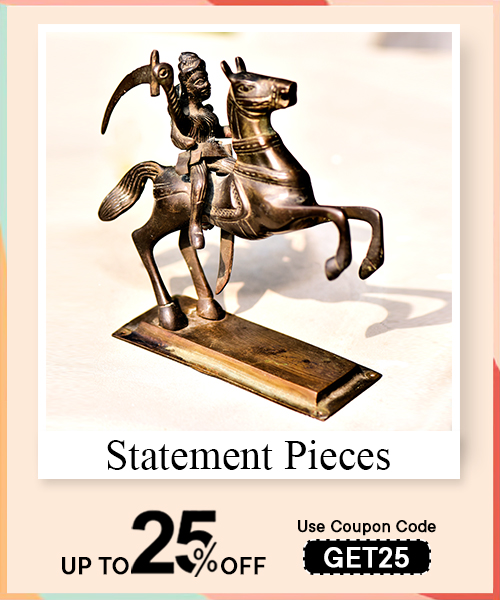Phad Painting is a traditional folk art form from Rajasthan, India, deeply embedded in the storytelling culture of the region.It features long scrolls or cloth canvases, hand-painted with narratives of local deities like Pabuji and Devnarayan. These visual tales were often performed by the Bhopas — folk singers and storytellers — who would carry the Phad and sing the legends depicted. The painting isn’t just decorative; it’s theatrical, devotional, and narrative. Rich in earthy colors and bold lines, Phad is both an art and a living performance. It speaks to a community’s memory, values, and spiritual legacy through vivid visuals.
What makes Phad painting truly special is its dynamic blend of art and performance. Unlike static artworks, a Phad comes alive in the night performances of the Bhopas, who narrate epic tales under the moonlight. Every inch of the scroll is packed with action — scenes of battle, devotion, and daily life — rendered in natural colors and intricate compositions. It’s not just storytelling; it’s a sacred ritual. The paintings are never signed, as they are offerings. This blend of devotion, folk tradition, and community makes Phad painting not only visually rich but spiritually and culturally profound.
The tradition of Phad painting is centuries old, passed down through the Joshi family of Bhilwara, who were the primary custodians of this craft. Traditionally, these paintings were created to narrate the heroic deeds of folk gods like Pabuji and Devnarayan. The Bhopa, both priest and performer, would carry the painted scroll and recount stories with music and voice, creating a traveling temple. The art was sacred, and even the process — from choosing the cloth to preparing natural dyes — followed rituals. Today, while modern themes enter Phad, its roots remain steeped in oral history and religious performance.
Phad paintings are defined by their narrative density, bold lines, and use of vibrant natural colors like indigo, yellow, red, and green. Human figures are stylized — often in profile, with exaggerated eyes and expressive gestures. Scenes are packed close together, with no empty space, creating a visual rhythm that supports storytelling. Each element has symbolic value, and the painting flows like a scrollable epic. These are not realistic depictions but highly interpretative illustrations designed to be understood from memory and tradition. The structure, palette, and purpose all contribute to a form that is both aesthetic and functional.
Read More : Elevate Your Space: Inspiring Wall Decor Ideas for Every Room
The style of Phad painting is distinctively folk and narrative-driven. It avoids realism and instead embraces symbolism and stylization to serve its storytelling purpose. The composition is horizontal, like a scroll, with each frame flowing into the next without linear separation. Figures are large and central, while backgrounds remain minimal. Faces are shown in profile, emotions in posture, and actions in repetitive motifs. The colors are organic, the themes mythological, and the aesthetic intentional — meant to be read aloud, performed, and experienced communally. It’s a storytelling style first and foremost, where visual art meets living oral tradition.
Phad painting is interesting not just for its visual vibrancy but for the life it breathes into stories. It isn’t merely art—it’s performance, memory, and ritual stitched into fabric. What makes it fascinating is how it travels; painted scrolls become storytelling canvases, carried by bards and narrated like epics under open skies. Unlike still images, these paintings move—through time, space, and tradition. The entire canvas is a stage. Gods, heroes, villagers—all have their moments. It’s not just about what you see, but how you listen to the tale flowing through colors, lines, and expressions. Phad doesn’t stay silent—it speaks.
Traditionally, Phad paintings are made on thick, handwoven cloth or canvas, treated with a wheat flour and gum paste to make it ready for the pigments. Natural dyes form the core of its palette—stone, minerals, plants, even cow dung, find their place in the color-making process. Brushes are often handmade from squirrel hair. Each material is local, organic, and ritualistically aligned with the act of creation. The process is sacred; artists often work in silence or prayer. It's less about quick execution and more about rhythm and patience. Every material used is infused with intention, creating not just a painting, but devotion.
The beauty of Phad lies in its layered narrative. It’s not just visual—it’s emotional, spiritual, and historical all at once. Each figure, gesture, and motif holds meaning. The composition flows like a river—without frames or separations—blending scenes and characters into a continuous saga. Vibrant earthy colors, meticulous detailing, and expressive faces create a living scene. It’s beautiful because it speaks of community, devotion, and memory, all carried on a single cloth. Its aesthetic comes not from symmetry but from soul. It celebrates imperfection and tradition, weaving stories of gods and mortals with a beauty born from belief and legacy.
Historically, "Phad" refers to the long, painted scroll used as a mobile temple. It means “fold” or “layer,” fittingly describing how the canvas is folded and carried by the Bhopas—wandering priest-singers of Rajasthan. These paintings were not hung on walls, but unfurled during night performances, accompanied by song and storytelling. The Phad was sacred—a moving shrine, not just art. It carried the lives and legends of deities like Pabuji and Devnarayan. It meant tradition, memory, and devotion stitched into one. In history, Phad wasn’t a possession—it was experience, mythology on cloth, brought alive by voice and community gatherings.
Phad paintings were created with a living purpose—they were never meant to be static or decorative. Their main role was to serve as storytelling devices for religious ballads. The Bhopas, who sang the epics of folk deities like Devnarayan and Pabuji, used Phad as their visual scripture. As they sang, they pointed to the figures, animating the narrative. It was temple, stage, and scripture combined. The purpose was not only to inform but to awaken devotion. It brought gods to life in villages without temples. Phad served as spiritual storytelling—bringing community, faith, and imagination together under moonlit skies.
Phad painting is a traditional folk art of Rajasthan that illustrates epic narratives of local deities, mainly Pabuji and Devnarayan. These are not isolated images but storytelling scrolls—narrative paintings that unfold as you read them. Meant for performance, they carry scenes of battles, miracles, rituals, and lives of folk heroes. The canvas is long and horizontal, painted in vibrant natural colors, often detailed and symbolic. It’s less about individual art and more about collective memory. Every inch holds movement. Every color holds meaning. Phad is where painting meets theatre—where the brush becomes a storyteller, and the cloth becomes a temple.
Phad paintings hold cultural, religious, and artistic significance. They serve as living scrolls of devotion—visual narratives that preserve the oral traditions of Rajasthan. These paintings aren't only about gods; they're about community, memory, and identity. Through them, folk heroes become immortal, and villagers stay connected to their roots. Phad is a bridge—between the sacred and the earthly, between performance and prayer. It's a rare art form where art, music, and ritual are inseparable. Their significance also lies in continuity. Passed down through generations, Phad painting keeps alive the voices of the past in colors that still echo today.
Phad paintings use a traditional palette made entirely of natural pigments. Each color holds symbolic value. Orange-yellow is often used for the base or skin tones, derived from stones or turmeric. Red from geru (red stone), green from indigo leaves or plants, black from soot, and white from chalk or lime. Blue is rarely used and if it appears, it’s subtle. The process of making these colors is slow, often ritualistic. Each hue is chosen not only for aesthetics but for meaning—symbolizing divinity, earth, energy, and harmony. These colors aren’t synthetic—they breathe with the painting, age with time, and glow with meaning.
Rajasthan is the state most famously associated with Phad painting. Particularly, the Bhilwara district and regions around Shahpura have long-standing connections with this art form. It’s here that the Joshi families, traditionally known as Phad painters, have preserved and passed on the legacy of this intricate narrative art for generations. Rajasthan’s arid landscapes, vibrant culture, and deep-rooted tradition of storytelling and folk devotion provide the perfect soil for Phad to thrive. The state doesn’t just host the painting—it breathes it. Phad is part of Rajasthan’s soul, a unique window into its mythology, rituals, and artistic resilience.
The Rajasthani folk art associated with Phad painting is simply called Phad itself, but the entire performance tradition that revolves around it is known as Phad Katha. While “Phad” refers to the painted scroll, “Katha” means storytelling. Together, they represent a complete folk tradition of song, story, and visual art. The Bhopa-Bhopi duo—singer and musician—breathe life into the Phad during night performances. It’s not just visual—it’s performative, immersive, and sacred. The art form exists both as visual narrative (Phad) and oral tradition (Katha), forming a cultural duet that is uniquely Rajasthani and deeply rooted in devotional practice.
Read More : A Comprehensive Guide to Kalamkari Painting
Phad paintings were traditionally created by the Joshi community of Rajasthan, particularly in the Bhilwara region. These skilled artisans passed down their craft through generations, often starting training at a young age. They used natural materials, intricate lines, and a devotional storytelling form to bring the lives of local deities, especially Pabuji and Devnarayan, to life. The Joshi artists were more than painters—they were visual narrators. Over time, artists like Shree Lal Joshi and Pradip Mukherjee played vital roles in popularizing Phad painting beyond rural boundaries, giving this traditional form a modern visibility without losing its soul.

Phad painting originates from Rajasthan, the culturally rich state in western India. Known for its vibrant traditions, Rajasthan gave rise to this unique scroll painting style rooted in Bhilwara and Shahpura. The art is more than just decorative—it's a form of religious storytelling deeply embedded in Rajasthani folklore. Wandering priests known as Bhopas would use these paintings as portable temples, unrolling them during performances. Thus, Phad is not just a Rajasthani art form—it’s a spiritual expression, echoing the colours, myths, and collective memory of its people, often performed under moonlight amidst the sand and silence of the desert.
A Phad painting can be recognized by its horizontal scroll format, bold outlines, earthy colors, and dense compositions filled with storytelling. Each painting typically depicts tales of local deities like Pabuji or Devnarayan, presented in scenes divided into narrative sections. The characters are usually shown in profile, and every inch of the canvas is filled—there’s no blank space. What sets Phad apart is not just the style but the function: it’s meant to be read or performed, not just seen. You'll find musical instruments, animals, warriors, and temples—all wrapped in a story that speaks directly to the viewer’s roots.
Phad painting is believed to be over 700 years old. Its origins trace back to medieval Rajasthan, where it emerged as a form of sacred scroll painting used by storytellers known as Bhopas. These paintings served as mobile temples, carried across villages to narrate epics of local heroes. The longevity of Phad reflects its adaptability and deep connection with oral traditions. While the earliest known examples are centuries old, the techniques and iconography remain consistent, held firmly in place by tradition. Even today, modern artists continue this lineage, making Phad a living heritage rather than a relic of the past.
The Phad reciters were known as Bhopas and Bhopis—wandering priests and storytellers who performed the tales illustrated in the Phad paintings. The Bhopa would sing and narrate the stories of local deities like Pabuji or Devnarayan, using the Phad as a visual aid during their night-long performances. The recitation was musical, theatrical, and deeply spiritual, often accompanied by the ravanhatta instrument. These performers didn’t just recite; they invoked the divine, turning storytelling into worship. Their knowledge was oral, passed down generations, and their role gave life to the paintings, making Phad both an art and a ritualistic experience.
Rajasthan, the land of kings, is home to several folk art forms, but one of its most iconic is Phad painting. Others include Pichwai, Mandana, and Kathputli puppetry. Each carries its own flavor, born out of local myths, rituals, and desert life. But among them, Phad stands out for its performative nature—where art and oral tradition merge. These folk arts are not mere decorations; they are living expressions, meant to be used, celebrated, and retold. They reflect the rhythm of rural life, the faith in legends, and the unmatched creative spark that Rajasthan has carried through generations.
The true speciality of Phad painting lies in its blend of storytelling, devotion, and community experience. Unlike framed art hung on walls, Phad is mobile, functional, and performative. Every scroll is a sacred canvas, meant to travel with the Bhopa priest and unfold the divine tales of folk gods like Pabuji. The painting isn't just seen—it’s sung, enacted, and worshipped. Its layout, rich with overlapping scenes, allows a flowing narrative, much like a visual epic. Each piece is handcrafted using natural dyes, layered with meaning and myth, and every figure speaks to a specific moment in a timeless story.
Phad paintings are known for their earthy, vibrant colours—all derived from natural sources. Traditional artists use a limited yet striking palette: yellow from turmeric, red from vermillion or geru, green from indigo leaves, blue from lapis or indigo, and black from lamp soot. Orange and white are also used, extracted from chalk and flowers. The pigments are mixed with gum and water, giving them a soft but enduring texture. Each colour is symbolic—red for bravery, green for nature, and so on. What makes these colours special is not just their source, but how they are layered with storytelling.
The traditional art of Rajasthan is a rich tapestry of forms—each region echoing a distinct identity. Among the most recognized is Phad painting, a scroll art form used in religious storytelling. There's also Pichwai from Nathdwara, Mandana floor designs, Miniature paintings from Jaipur and Mewar, and Kathputli puppetry. These art forms often draw from epics, folklore, and daily life. They are functional, ceremonial, and deeply spiritual. Crafted with natural dyes and practiced for centuries, traditional Rajasthani art is not just about beauty—it’s about belonging, memory, and the cultural fabric that keeps stories alive even as times change.
In art, the four main types of colors are primary, secondary, tertiary, and neutral. Primary colors—red, yellow, and blue—are the foundation; they can’t be made by mixing other colors. Secondary colors like green, orange, and violet come from mixing two primaries. Tertiary colors are blends of a primary and a secondary—like red-orange or blue-green. Neutral colors include black, white, gray, and sometimes brown, used to tone or balance a composition. Each type has a role, shaping mood, depth, and contrast. Together, they form the backbone of color theory, guiding painters through harmony and visual storytelling.
When we talk about color in art, we usually refer to six essential elements: hue, value, intensity (or saturation), temperature, tint, and shade. Hue is the name of the color itself. Value refers to how light or dark a color appears. Intensity is the vividness or dullness of a color. Temperature separates colors into warm (reds, yellows) and cool (blues, greens). Tint is a color lightened by white, while shade is a color darkened by black. These elements let artists control emotion, focus, and storytelling, much like tone and punctuation shape writing. Each color holds purpose beyond the surface.
The three core colors in art are red, yellow, and blue—the primary colors. They are the starting point of all other hues and cannot be created by mixing any other colors together. From these three, secondary and tertiary colors emerge, creating the full spectrum. In essence, red evokes energy and passion, yellow represents warmth and optimism, and blue brings calm and depth. These three colors hold symbolic power across cultures and serve as emotional cues in visual narratives. Their simplicity forms a complex base for creative exploration, much like three words building a thousand possibilities in a poem.
A mother color in art is a base hue that unifies a painting’s entire palette. Think of it as a thread that subtly runs through every element—sky, skin, fabric, or background. Artists often mix a small amount of this color into every other color used, giving the piece harmony and emotional coherence. It might not dominate the canvas, but its presence is felt, creating visual rhythm. The concept is intuitive and poetic—like a tone in music or a recurring phrase in literature. The mother color ties together contrasts, shadows, and highlights, whispering continuity across the composition.
The colors you choose for painting depend on your subject, style, and the emotion you wish to convey. However, a basic palette often includes primary colors (red, yellow, blue), secondary colors, earth tones like burnt sienna, ochre, umber, and neutral tones for balancing. Cool tones like ultramarine or phthalo blue offer calmness, while warm tones like cadmium red or lemon yellow spark energy. In traditional Indian art, colors like vermillion, indigo, and turmeric yellow hold symbolic depth. Ultimately, your choices reflect your narrative—like characters in a story—each color playing a part, building mood, form, and storytelling together.
Traditional art, especially from cultural lineages like Indian, Persian, or European classical schools, often employs earthy, mineral-based, and plant-derived colors. Think of indigo, vermilion, ochre, lamp black, and lapis lazuli. These colors come from natural sources—stone, plants, metals—and carry rich cultural symbolism. Indian miniature paintings use vibrant yet grounded hues like turmeric yellow, charcoal black, and brick red. In European tradition, muted tones dominated early works, with richer hues emerging during the Renaissance. These traditional colors aren’t just pigment—they carry legacy, emotion, and ritual. They ground a painting in time and place, lending authenticity and soul.
Phad painting, a traditional Rajasthani folk art form, is known for its narrative storytelling, vibrant natural colors, and scroll-style composition. Painted on long cloth (phad), it depicts epics of folk deities like Pabuji or Devnarayan. The style is two-dimensional, with figures facing front, large eyes, and minimal depth. Colors are symbolic—red for valor, yellow for divinity. Phad is meant to be read like a moving scroll, often performed with music and narration. Each painting is not just visual—it’s a performance, an archive, a ritual. Its detailing, symmetry, and handmade precision reflect both devotion and craftsmanship.
Art colors have poetic, evocative names rooted in origin, tone, or purpose. Some common ones include Cadmium Red, Ultramarine Blue, Lemon Yellow, Burnt Umber, Viridian Green, Titanium White, Payne’s Grey, Alizarin Crimson, Cobalt Blue, and Indian Yellow. In traditional Indian painting, colors like Geru (red ochre), Neel (indigo), and Haldi (turmeric yellow) are prominent. Names often signal the pigment’s source—natural minerals, plant dyes, or synthetic chemicals. These names are like titles in a story, giving personality and historical depth to a color. Each holds a unique character, behaving differently with light, canvas, and brushstroke.
The color circle, or color wheel, is a visual representation of how colors relate to one another. It includes primary colors (red, yellow, blue), secondary colors (green, orange, violet), and tertiary colors (like red-orange or blue-green). It also divides colors into warm and cool tones. Artists use the color wheel to build harmony, contrast, and balance. Complementary colors (opposites on the wheel) like blue and orange create strong contrast, while analogous colors (side-by-side) offer smooth blending. Like a map, the color circle guides emotional direction in art—helping the painter navigate mood, tension, and composition.
Read More : General Understanding of Scenery Painting
Preserving a Phad painting involves respecting its materials and tradition. Keep it away from direct sunlight to prevent color fading. Use acid-free mounts or cloth backing, and if framed, ensure UV-protected glass. Avoid humidity and pests; store in dry, cool spaces. Handle with clean hands or gloves. If the Phad is very old or valuable, consult a restoration expert. Since it's hand-painted with natural dyes, care must be traditional yet informed. Regular dusting with a soft brush helps. Like sacred scripts, a Phad isn't just art—it’s storytelling and heritage wrapped in color. Its preservation is an act of devotion.















